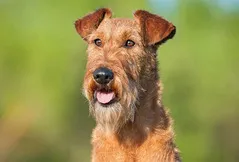
Russian Toy
The Russian Toy is a very small breed of dog originally bred in Russia from the English Toy Terrier which is known today as the Manchester Terrier.
Overall Status
| Height | 8 to 11 inches |
| Temperament | Loyal, Smart, Charming |
| Weight | Up to 6.5 pounds |
| Life Expectancy | 12 to 14 years |
| Coat Color | Black and Tan, Blue, Brown |
| Barking Level | Likes To Be Vocal |
Quick Factors
| Playfulness | |
| Dog Friendly | |
| Exercise Need | |
| Grooming Needs | |
| Strangers Friendly | |
| Family Affectionate |
Daily Care
Grooming Tips
The longhaired variety requires more grooming than the smooth-coated variety for obvious reasons. The long coat has body hair from 1-3 inches long. Their ears are covered with thick, long hair forming a fringe, and there are distinct feathers on the rear side of his limbs. The longhaired variety should be brushed two to three times per week and fringes should be kept free of debris. Monthly baths with high-quality shampoo and conditioner are usually enough to keep the coat healthy.For both coat types, bathe as needed. That can be monthly or more often. If he’s sleeping under the covers with you, a weekly or biweekly bath may be in order. Be sure to brush him thoroughly before bathing to remove any tangles or mats.The rest is basic care: Trim the nails every few weeks. Brush the teeth often — with a vet-approved pet toothpaste — for good overall health and fresh breath.
Exercise Tips
The Russian Toy may be small but it is a fairly active breed that requires plenty of daily exercise. This breed was developed as both a watchdog and a rat dog so it may be prone to chasing small animals.Because small dogs have more fragile necks and tracheas than large dogs, it is recommended that a leash be attached to a harness instead of a collar when walking your Russian Toy. It is also recommended that you do not leave a collar or harness on your Russian while in your home. Many times a collar or harness can get caught on things around the house and injure your little imp.
Feeding Tips
As a small-breed dog, the Russkiy Toy has fairly high energy needs because it has a fast metabolism. This being the case, you should offer your dog a food diet specially formulated for small- or toy-breed dogs.If you get a Russkiy Toy puppy from a breeder, they would give you a feeding schedule and it's important to stick to the same routine, feeding the same puppy food to avoid any tummy upsets. You can change a puppy's diet, but this needs to be done very gradually always making sure they don't develop any digestive upsets and if they do, it's best to put them back on their original diet and to discuss things with the vet before attempting to change it again.Older dogs are not known to be fussy or finicky eaters, but this does not mean you can feed them a lower quality diet. It's best to feed a mature dog twice a day, once in the morning and then again in the evening, making sure it's good quality food that meets all their nutritional requirementsTreatscan be an important aid in training, but giving too many can cause obesity. Learn about whichhuman foodsare safe for dogs, and which are not. Check with your vet if you have any concerns about your dog’s weight or diet.Clean, fresh water should be available at all times.
Health Tips
The Russian Toy is a fairly healthy breed, though it is prone to several musculoskeletal issues including patellar luxation and bone fractures. He may also need the help of a vet to remove puppy teeth in order to make room for permanent teeth to grow in.Responsible breedersscreen their stock for health conditions such as progressive retinal atrophy (PRA) and patellar luxation, and owners should be aware of the risk for eye injuries, such as ulcers.
Trainability
The Russian Toy is a smart breed which makes him fairly easy to train. Like many smaller breeds, however, the Russkiy Toy is prone to developing Small Dog Syndrome if you do not maintain the proper authority. Positive reinforcement training methods are recommended and you need to maintain a firm and consistent hand in training.The RTCA, the breed’s AKC parent club, highly recommends early socialization of your puppy. Many all-breed kennel clubs, community centers, and veterinarians offer puppy kindergarten classes as well as many levels of obedience training.
History
The history of the Russian Toy began with English stock and dates back as early as the 18thcentury when the English Toy Terrier arrived in Russia. Evidence of this can be seen at the Zoological Museum in St. Petersburg, where a preserved specimen of a small black and tan terrier from 1716-1725, stands on exhibit. The specimen stands approximately 14 inches at the withers with the inscription: “Dog of the sleek-haired terrier breed named Lisetta belonged personally to Peter the Great.”In 1958, a longhaired maledogwas born from a breeding of two smooth-coated Russian Toys. The dog, named Chiky, was bred to a female who had slightly long hair, and their offspring became the foundation of what was then known as the Moscow Longhaired Toy Terrier.Eventually, the two types became one breed with two varieties: longhaired and smooth-haired. Dogs with smooth coats tend to have short, shiny coats, while those with long coats have feathering on the limbs, tails, and ears, as well as a ruffle of hair on the chest.In 2006, with the Russian Toy’s addition to the FCI list of recognized breeds, the “Terrier” was dropped from the breed’s name and is now called the Russian Toy, with both long and smooth coat varieties.






